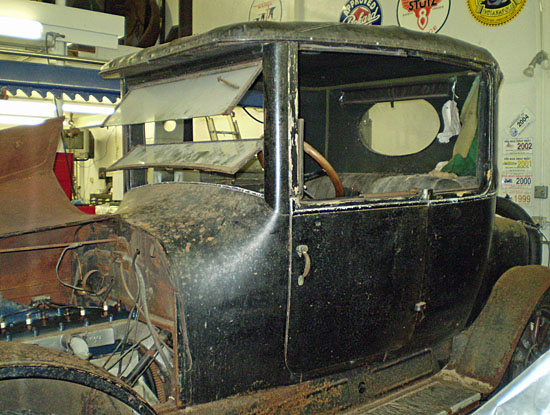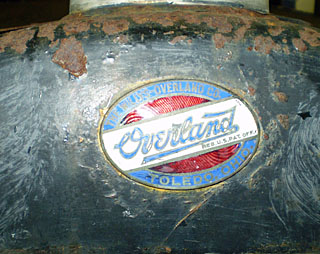Historical Society restoring antique car
DAVE MOSIER/independent editor

What has been a dream for former body shop owner Dave Agler and his small band of Van Wert County Historical Society volunteers is now in pieces. Hundreds of pieces. Or, more appropriately, parts … auto parts.
Agler’s dream is to renovate a 1917 Overland Opera Touring Coupe, a rare 4-cylinder automobile that was built in August 1916 and first owned by Charles Wassenberg of Wassenberg Art Center fame. At the present time, parts for the vehicle are scattered all over town and in other area communities so that restoration work can be completed.
Purchase of the car for $5,000 was spearheaded by local resident Dave Kirchenbauer, while financial assistance to buy it was provided by The Van Wert County Foundation, First Bank of Berne, Van Wert Federal Savings Bank, Citizens National Bank, Rick Sealscott CPA and Randy Myers of Leland Smith Insurance.
The Overland Company was first started in Indianapolis, Ind., and later moved to Toledo, where it was purchased by John North Willys in 1908. Willys changed the name of the company to Willys-Overland, and later made what he called Jeeps for the United States during World War II.
The company was later purchased by what was then American Motors and is currently owned by Chrysler Corporation.
Agler said the 1917 Overland being restored is in decent condition, considering its age.
“For being nearly 100 years old, it’s in pretty good shape,” Agler said of the car, which was purchased from the Paul Jones family about a year ago. Bill Jones originally purchased the vehicle in 1952 from the Wassenberg estate after what was the Wassenbergs’ home on South Washington Street was turned into what is now Wassenberg Art Center.
Jones’ brother, Paul, who used to own a men’s clothing store in Van Wert, later bought the car and then passed it down to his son, Dick, who sold it to the Historical Society. The car was originally sold to the Jones family because those operating the art center needed the garage then housing the car to display artwork (this was before the current art center annex was built).
But while the metal portions of the vehicle are in pretty good shape, the frame of the vehicle needs lots of work.
Like many cars of the day, the undercarriage of the Overland was made of wood, mostly because companies that used to make buggies also made the early car frames, and that portion of the vehicle hasn’t fared all that well because of termite damage that occurred when it was stored in the Orlando, Fla., area.
Agler said Siefker Lumber donated the wood for the frame, while Jim Schneider, Fred Hartwig and Stan Schumm will be rebuilding that portion of the vehicle. Others working on the car, in addition to Agler and Kirchenbauer, include Mike Spray, Larry Oechsle and Bob Stanley, while NAPA Auto Parts has donated paint supplies for the project.
Fortunately, Agler said, most of the parts for the car are still with the vehicle, although some will need reworking — and others made from scratch — to ensure the car will run after renovations are complete.
“I would venture to say, if we don’t look at the termites and what they’ve destroyed, the car is 95 percent there,” said Agler, who owned and operated Heffner’s Body Shop in Van Wert for a decade until he sold it in 1997.

Money is needed, though, to completely restore the car, since some parts will have to be made especially for the car. That’s because many of the parts needed haven’t been manufactured for more than 50 years and are virtually impossible to find.
Agler said restoring the engine, which is being done at Hart’s Machine Shop in Cecil, will cost approximately $5,000, with some parts having to be made since replacement parts can no longer be found.
As much as $15,000 may be needed to restore the interior and top of the vehicle, which is currently of leather.
The Historical Society is hoping that area residents will at least consider making a small (or large) donation to the project so volunteers who are donating hundreds of hours of their time to work on the vehicle, can complete refinishing the car.
The money will be well-spent, said Historical Society Trustee Ron Kessler, who noted that insurers have told the society to insure the car for $100,000 after it’s fully restored.
POSTED: 01/28/12 at 6:44 am. FILED UNDER: News







